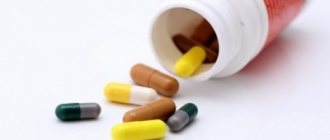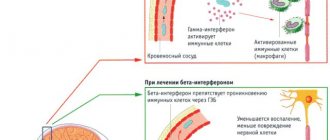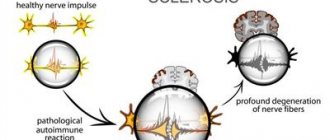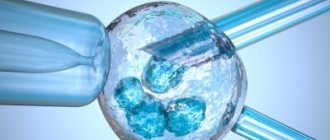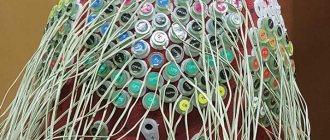Multiple sclerosis (MS) is a chronic progressive disease of the central nervous system, characterized by the presence of pathological neurological symptoms. Refers to a demyelinating disease, the main cause of which is the destruction of myelin - the protein shell of the axon, the process of the neuron.
As a rule, the onset of the disease occurs at a young age, up to 45 years, but currently cases of the development of this pathology have been described in both childhood and old age. Women get sick more often. In addition, a pattern of more frequent development of the disease in countries with good sanitary and hygienic conditions has been identified.
Some scientists associate this with the late maturation of immunity in children growing up in a favorable sanitary environment. There is no clear opinion about its hereditary nature. However, it has been proven that the main risk factors are chronic stressful situations and infections (Epstein-Barr virus). Reduced vitamin D levels, smoking, environmental factors, and nutrition are important.
An important factor for successful treatment of multiple sclerosis is its diagnosis at an early stage of development.
Blood analysis
Laboratory tests for MS play a supporting role. Imaging methods are used for diagnosis. Only the presence of foci of demyelination allows a diagnosis to be made and treatment to begin. But MRI is a complex and expensive procedure. And it needs to be done every six months.
Therefore, scientists around the world are developing an effective test to detect MS in the early stages. There is a search for markers that increase during the autoimmune process. And the first results have already been received. We will talk about this in detail below.
Complete blood count (CBC)
How to submit?
Blood is taken from a finger or from a vein. The first method is preferable. The test is performed on an empty stomach. At least 8 hours must pass after the last meal.
What is UAC used for?
The test shows any changes in the body. It's non-specific. During the inflammatory process, there is an increase in leukocytes, lymphocytes and ESR. In patients with MS during remission, the analysis does not show any changes.
Preparing for the study
No special preparation is required. It is better to donate blood on an empty stomach.
Side effects
Blood is taken from a finger using a special instrument. The laboratory technician uses individual gloves for each patient. Use a sterile scarifier or lancet. If sanitary standards are observed, there are no complications.
| Indicators | Norm | For MS |
| Leukocytes | 4-9 at 109 | Possible increase during exacerbations |
| Red blood cells | 3.7-5.1 per 1012 | Without changes |
| Platelets | 180-400 at 109 | Without changes |
| Hemoglobin | 120-160 g/l | Without changes |
| Hematocrit | 34-46% | Without changes |
| Formula: rod | 1-6% | Without changes |
| Segmented | 47-72% | Possible decrease in performance |
| Eosinophils | 0-5% | Without changes |
| Basophils | 0-1% | Without changes |
| Lymphocytes | 20-40% | Possible promotion |
| Monocytes | 2-9% | Without changes |
Biochemical blood test (BAC)
How to submit?
Blood is drawn from a vein. The cubital vessel in the cubital fossa is used. If it is impossible to carry out analysis here, any accessible place is punctured (femoral vein, veins of the forearm or hand).
What is BAK used for?
The test reflects the work and function of organs. It is nonspecific for MS. During illness, changes in the ratio of blood proteins are formed. Globulin fractions increase.
Preparing for the study
Blood is donated on an empty stomach. You must not smoke before the examination. The day before you should avoid eating fatty foods.
Side effects
Hematomas at the puncture site are possible if the sampling technique is violated or if the vessel becomes fragile. In rare cases, phlebitis and thrombophlebitis of the cubital veins form.
| Indicators | Norm | For MS |
| Total protein (fractions) | 65-83 g/l | Possible increase during exacerbations due to the globulin fraction |
| Bilirubin (total, free and bound) | 3.4-17.1 µmol/l1-7.9 µmol/l 1-19 µmol/l | Promotion due to common and free faction |
| ALAT/ASAT | up to 45/up to 37 units | Without changes |
| Urea | 2.8-7.2 mmol/l | Possible promotion |
| Creatinine | 53-115 µmol/l | Possible promotion |
| GGTP | Up to 55 units | Without changes |
| Alkaline phosphatase | 30-120 U/l | Without changes |
| Uric acid | 150-420 µmol/l | Without changes |
| Potassium/Sodium | 3,5-5,5/135-145 | Without changes |
| Chlorine | 98-107 | Without changes |
| CRP (c-reactive protein) | 0-5 mg/l | Possible increase during exacerbation |
Routine biochemical testing is not used to diagnose multiple sclerosis. Changes in tests are nonspecific and depend on the patient’s age and the presence of concomitant diseases.
Other tests
The role of vitamin D deficiency in the development of multiple sclerosis is now being actively discussed. It is known that residents of northern latitudes are more likely to suffer from the disease, while patients who received the supplement responded better to treatment. Therefore, once the diagnosis is established, it is recommended to undergo a calciferol 25-OH test.
How is it surrendered?
The test is performed on an empty stomach. Blood is donated from a vein. Avoid taking vitamin D supplements or medications the day before.
Why is it used in diagnostics?
A correlation has been found between vitamin deficiency and the progression of disease symptoms.
Side effects
Blood is drawn from a vein. After manipulation, hematoma, phlebitis and thrombophlebitis of the cubital vessel may appear.
Normal European values for total vitamin D:
- 60 – 100 ng/ml;
- 150-250 nmol/l.
Standards of the Russian Association of Endocrinologists:
| Norm | 30-100 ng/ml |
| Failure | 20-30 ng/ml |
| Shortage | Less than 20 ng/ml |
Treatment
It is important that people find a specialist who is familiar with treating MS. People with MS need a broad approach to managing symptoms and the course of the disease.
There are many medications that can be used to slow the progression of the disease and treat symptoms associated with recurrent forms of the disease. However, there are currently no drugs to treat primary progressive MS (PPMS), which is a non-recurring type of MS.
The use of medications depends on the individual and the symptoms, stage and severity of the disease. Medicines are also used to treat relapses as needed.
People with MS may consider participating in a rehabilitation program that focuses on maintaining the strength and function of the body's muscles.
Finally, it is important to work with a health care provider who recognizes the importance of emotional health and coping mechanisms and can provide appropriate referrals.
Analysis of urine
The test has no diagnostic value. It is an indicator of the body's functioning. Included in the examination protocol for any disease.
How is it surrendered?
The analysis is delivered to the laboratory in a special sterile container. It is better to perform the analysis in the morning.
Why is it used in diagnostics?
The test shows the function of the urinary system. Included in the examination protocol.
How to submit?
A general urine test is taken in the morning. Before donation, you should purchase a sterile container. Carry out hygiene procedures. A medium portion of urine is delivered to the container.
Indicators
In MS there are no changes in urine tests.
| Color | Straw yellow |
| Relative density | 1010-1025 |
| Acidity | Acidic/slightly acidic |
| Protein | None |
| Sugar | None |
| Epithelium | No more than 5 cells |
| Red blood cells | No more than 1 cell |
| Leukocytes | No more than 6 cells |
| Bacteria | None |
Symptoms
| Occurrence (how often a symptom occurs in a given disease) | |
| Apathy (indifference, indifference) | 60% |
| Depression | 60% |
| Goosebumps on the leg | 60% |
| Goosebumps on the arm | 60% |
| Decreased visual acuity (deterioration of vision, poor vision) | 60% |
| Numbness of the lower body | 50% |
| Numbness of one, two or all limbs | 50% |
| Gradually increasing weakness in the leg muscles (leg weakness) | 50% |
| Gait disturbance, difficult to specify (abasia) | 40% |
| Increased irritability (nervousness, psychosis) | 40% |
| Inability to hold back urination when you feel the urge | 30% |
| Transient blindness in one or both eyes | 30% |
| Memory loss (memory impairment, poor memory, memory impairment, forgetfulness) | 30% |
| Double vision (diplopia) | 25% |
| Changing your voice tone | 20% |
| Weakness in the arm (right or left) | 20% |
| Strabismus | 10% |
CSF analysis
Cerebrospinal fluid (CSF) testing should be performed at any stage of the disease. Immunoglobulins G appear in the cerebrospinal fluid in response to inflammation. During an exacerbation, the Ig titer increases.
In addition to the general CSF test, immunoglobulin clonality studies are used. In acute inflammation, a polyclonal immune response is detected. This means that many protective antigens are formed. As the disease enters the chronic phase, the number of clones decreases. Ig oligoclonality predominates in cerebrospinal effusion.
How is it surrendered?
Liquor is obtained during a spinal puncture. This is a medical procedure performed in a hospital setting. For this, special lumbar needles with an oblique section are used.
Under aseptic conditions, the doctor performs a puncture at the level of 3-5 lumbar vertebrae. After this, the liquid is collected into a test tube and sent for testing. The injection site is sealed with an aseptic bandage. The patient is asked to lie down for 2-3 hours.
FACT! Additionally, a venous blood test is taken
Why is it used in diagnostics?
In multiple sclerosis, the immune system attacks nerve cells. There are practically no changes detected in the blood. But the cerebrospinal fluid, which washes the brain and spinal cord, is in close contact with the area of inflammation and contains its markers.
How do you prepare for it?
Hospitalization is required for the study. It takes no more than a day. After the manipulation, you should not get up for some time. Sudden activation can lead to headaches. Nowadays special needles are used that contribute to less trauma to the hard shell. The puncture wound heals quickly.
Side effects
The most common complication is bleeding from a damaged vessel. Sometimes cephalgia appears after manipulation (severe headache), pain in the lower extremities. If sterility is not maintained, infection enters the central nervous system. The puncture needle sometimes breaks in soft tissues.
With the correct technique and highly qualified doctor, no complications are observed. To prepare, the patient is given anesthesia or a mild sedative.
Indicators
Norm and pathology during lumbar puncture:
| Norm | For multiple sclerosis | |
| Color | Colorless | No dynamics |
| Transparency | Transparent | Rarely altered by cytosis |
| Pressure | 300-400 mm.water. Art. | Increased |
| Density | 1003-1008 | Increased |
| Cytosis | 0-3 in µl | Increased |
| Reaction | 7,35-7,8 | Rarely changes |
| Protein | 0.22-0.33 g/l | May increase |
| Glucose | 2.78-3.8 mmol/l | Doesn't change significantly |
| Chloride | 120 mol/l | Does not change |
Immunoglobulin clones and protein fractions are of diagnostic importance. Determined by isoelectric focusing and enzyme immunoassay.
Indicators
| Synthesis type | The nature of the determination of IG in the cerebrospinal fluid | Interpretation |
| 1 | Polyclonal | Acute inflammatory disease |
| 2 | Oligoclonal (polyclonal in blood serum) | 85-90% debut RS |
| 3 | Oligoclonal (oligoclonal in the blood) | Appears in MS, systemic lupus erythematosus, encephalitis and sarcoidosis. |
Anti-MAG
The study of antibodies to myelin glycolipids and sulfatide in blood serum has diagnostic value. Their titer is determined in the group of patients with a secondary progressive course. An enzyme immunoassay is used for diagnosis. During therapy, the level of anti-MAG should fall.
How is it surrendered?
Blood and cerebrospinal fluid are used for the study.
Why is it used in diagnostics?
Scientists are identifying a connection between the activity of certain forms and the success of therapy.
Objective neurological examination
During the examination, the doctor uses a special hammer to identify areas of damage to the white matter. It is important to identify areas affected at different times. For this purpose the following are assessed:
- muscle tone and strength, limb movements
- superficial and deep sensitivity.
- sensations of temperature, touch and pain in symmetrical areas;
- correct functioning of the cranial nerves. The fact of strabismus, double vision, loss of visual fields is revealed;
- movements of the muscles of the face, tongue, neck, pharynx;
- the presence of hand tremors, changes in handwriting, unsteadiness in the Romberg position.
It is advisable to conduct examinations over several days to compare functional changes. One of the characteristic signs of MS is the loss of abdominal reflexes at the first appointment and recovery by the next appointment.
Other tests
A comprehensive diagnostic test for MS (oligoclonal IgG and kappa/lambda light chains of immunoglobulins in the cerebrospinal fluid) allows you to complement the diagnosis.
How is it surrendered?
For research, cerebrospinal fluid is taken in a hospital setting.
Why is it used in diagnostics?
Necessary for accurate diagnosis, monitoring treatment and preventing exacerbations.
How do you prepare for it?
Preparation as for a lumbar puncture.
NORMAL VALUES
Kappa and lambda light chains are markers of intrathecal inflammation. Normally they are absent.
Prices and clinics
| Clinics | Performed tests | Prices |
| St. Petersburg State Medical University named after. Pavlova | Oligoclonal immunoglobulin G in cerebrospinal fluid and blood | 2950 rub. |
| Scientific Center for Neurology (Moscow) | Oligoclonal immunoglobulin G in cerebrospinal fluid and blood | About 3000 rubles |
| City Clinical Hospital No. 31 (St. Petersburg) City Center for the Treatment of MS | Oligoclonal immunoglobulin G in cerebrospinal fluid and blood | Diagnostics are carried out on an extra-budgetary and budgetary basis |
| Yusupov Hospital (Moscow) | Oligoclonal immunoglobulin G in cerebrospinal fluid and blood | Diagnostics are carried out on an extra-budgetary and budgetary basis |
| Invitro (branches in major cities of Russia) | Oligoclonal immunoglobulin G in cerebrospinal fluid and blood Comprehensive test for the diagnosis of MS (oligoclonal IgG and kappa/lambda light chains of immunoglobulins in cerebrospinal fluid) | 4600 rubles Prepared within 12 working days |
| Blood test for multiple sclerosis at Gemotest (branches in major cities of Russia) | Free lambda chains of immunoglobulins in cerebrospinal fluid Detection of oligoclonal immunoglobulin IgG in cerebrospinal fluid and blood serum Free kappa chains of immunoglobulins in cerebrospinal fluid | 5230 rubles Prepared within 12 working days |
Multiple sclerosis is quite difficult to diagnose. MRI data and time-consuming tests are required. But the sooner the disease is confirmed, the sooner doctors prescribe therapy. It is thanks to her that new exacerbations of MS appear less and less often, even in patients with severe forms.
How to diagnose multiple sclerosis yourself
This pathology, as a rule, is identified by characteristic symptoms and when collecting an anamnesis.
Quite often, patients show signs of damage to the pyramidal tract: paraparesis, monoparesis, hemiparesis. Optic neuritis, horizontal and vertical nystagmus, and diplopia are characteristic. Vestibular changes with damage to the cerebellar structures, spastic paralysis, scanned speech and macrography, static and dynamic ataxia, tremor, changes in sensitivity, Lhermitte’s symptom, changes in the function of the pelvic organs, including sexual, changes in mood, mental and intellectual functions.
Due to such a variety of manifestations of the disease, the patient should, in the presence of any neurological changes, and especially if several are combined, seek advice from a qualified neurologist. On your own, you can only suspect multiple sclerosis in the presence of the above clinical forms, but diagnosis should be carried out in a medical institution.
